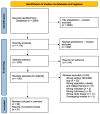Associations of Maternal Nutritional Status and Supplementation with Fetal, Newborn, and Infant Outcomes in Low-Income and Middle-Income Settings: An Overview of Reviews
- PMID: 39519557
- PMCID: PMC11547697
- DOI: 10.3390/nu16213725
Associations of Maternal Nutritional Status and Supplementation with Fetal, Newborn, and Infant Outcomes in Low-Income and Middle-Income Settings: An Overview of Reviews
Abstract
Background/objectives: Despite advances in maternal nutritional knowledge, the effect of maternal diet, micronutrient status and undernutrition, and the effect of maternal supplementation on fetal, neonatal and infant outcomes still have gaps in the literature. This overview of reviews is intended to assess the available information on these issues and identify the main maternal nutritional factors associated with offspring outcomes in low- and middle-income countries as possible targets for public health interventions.
Methods: The literature search was performed in Medline (PubMed) and Cochrane Library datasets in June 2024. Pre-specified outcomes in offspring were pooled using standard meta-analytical methods.
Results: We found consistent evidence on the impact of maternal undernutrition indicated by low body mass index (BMI), mid-upper arm circumference (MUAC), and stature, but not of individual micronutrient status, on intrauterine-growth retardation, preterm birth, low birth weight, and small for gestational age, with research showing a possible effect of maternal undernutrition in later child nutritional status. Studies on micronutrient supplementation showed possible beneficial effects of iron, vitamin D, and multiple micronutrients on birthweight and/or decreasing small for gestational age, as well as a possible effect of calcium on preterm birth reduction. Interventions showing more consistent beneficial outcomes were balanced protein-energy and lipid base supplements, which demonstrated improved weight in newborns from supplemented mothers and a decreased risk of adverse neonatal outcomes.
Conclusions: Further research is needed to identify the benefits and risks of maternal individual micronutrient supplementation on neonatal and further child outcomes.
Keywords: intrauterine growth restriction; low birthweight; maternal under-nutrition; prenatal supplementation; preterm birth; small for gestational age.
Conflict of interest statement
The authors declare no conflicts of interest. The funders had no role in the design of this study, in the collection, analyses, or interpretation of data, in the writing of the manuscript, or in the decision to publish the results.
Figures



Similar articles
-
Vitamin and Mineral Supplementation During Pregnancy on Maternal, Birth, Child Health and Development Outcomes in Low- and Middle-Income Countries: A Systematic Review and Meta-Analysis.Nutrients. 2020 Feb 14;12(2):491. doi: 10.3390/nu12020491. Nutrients. 2020. PMID: 32075071 Free PMC article.
-
Multiple-micronutrient supplementation for women during pregnancy.Cochrane Database Syst Rev. 2019 Mar 14;3(3):CD004905. doi: 10.1002/14651858.CD004905.pub6. Cochrane Database Syst Rev. 2019. PMID: 30873598 Free PMC article.
-
Modifying effect of maternal nutritional status on the impact of maternal multiple micronutrient supplementation on birthweight in Indonesia.Eur J Clin Nutr. 2011 Oct;65(10):1110-7. doi: 10.1038/ejcn.2011.97. Epub 2011 Jun 15. Eur J Clin Nutr. 2011. PMID: 21673719 Clinical Trial.
-
Multiple micronutrient supplementation during pregnancy in low-income countries: a meta-analysis of effects on birth size and length of gestation.Food Nutr Bull. 2009 Dec;30(4 Suppl):S533-46. doi: 10.1177/15648265090304S408. Food Nutr Bull. 2009. PMID: 20120795 Free PMC article.
-
Modifiers of the effect of maternal multiple micronutrient supplementation on stillbirth, birth outcomes, and infant mortality: a meta-analysis of individual patient data from 17 randomised trials in low-income and middle-income countries.Lancet Glob Health. 2017 Nov;5(11):e1090-e1100. doi: 10.1016/S2214-109X(17)30371-6. Lancet Glob Health. 2017. PMID: 29025632
Cited by
-
Prenatal Factors Influencing Calf Morbidity and Mortality in Dairy Cattle: A Systematic Review of the Literature (2000-2024).Animals (Basel). 2025 Jun 16;15(12):1772. doi: 10.3390/ani15121772. Animals (Basel). 2025. PMID: 40564326 Free PMC article. Review.
-
Association between three-timepoint maternal blood pressure trajectories during pregnancy and low birth weight: a longitudinal study based on NHANES 2005-2006.Front Pediatr. 2025 Jun 19;13:1604845. doi: 10.3389/fped.2025.1604845. eCollection 2025. Front Pediatr. 2025. PMID: 40612487 Free PMC article.
-
Notch signaling pathway regulates the progression of fetal growth restriction through mediating immune dysfunction.Biomed Rep. 2025 May 6;23(1):111. doi: 10.3892/br.2025.1989. eCollection 2025 Jul. Biomed Rep. 2025. PMID: 40386306 Free PMC article.
-
Co-occurrence of maternal anemia and child undernutrition in Ethiopia: multilevel analysis of analysis of EDHS data (2005-2016).BMC Public Health. 2025 Aug 11;25(1):2722. doi: 10.1186/s12889-025-23961-0. BMC Public Health. 2025. PMID: 40790471 Free PMC article.
References
-
- WHO Low Birth Weight. Nutrition Landscape Information System (NLiS): World Health Organization. 2024. [(accessed on 10 June 2024)]. Available online: https://www.who.int/data/nutrition/nlis/info/low-birth-weight.
-
- Victora C.G., Christian P., Vidaletti L.P., Gatica-Dominguez G., Menon P., Black R.E. Revisiting maternal and child undernutrition in low-income and middle-income countries: Variable progress towards an unfinished agenda. Lancet. 2021;397:1388–1399. doi: 10.1016/S0140-6736(21)00394-9. - DOI - PMC - PubMed
-
- UNICEF The State of Food Security and Nutrition in the World 2024: Financing to End Hunger, Food Insecurity and Malnutrition in All Its Forms. 2024. [(accessed on 18 October 2024)]. Available online: http://icsfarchives.net/20253/
Publication types
MeSH terms
Substances
Grants and funding
LinkOut - more resources
Full Text Sources
Medical

